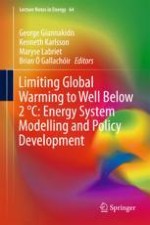2018 | OriginalPaper | Buchkapitel
The Importance of the Water-Energy Nexus for Emerging Countries When Moving Towards Below 2 °C
verfasst von : Gary Goldstein, Pascal Delaquil, Fadiel Ahjum, Bruno Merven, Adrian Stone, James Cullis, Wenying Chen, Nan Li, Yongnan Zhu, Yizi Shang, Diego Rodriguez, Morgan Bazilian, Anna Delgado-Martin, Fernando Miralles-Wilhelm
Erschienen in: Limiting Global Warming to Well Below 2 °C: Energy System Modelling and Policy Development
Aktivieren Sie unsere intelligente Suche, um passende Fachinhalte oder Patente zu finden.
Wählen Sie Textabschnitte aus um mit Künstlicher Intelligenz passenden Patente zu finden. powered by
Markieren Sie Textabschnitte, um KI-gestützt weitere passende Inhalte zu finden. powered by
